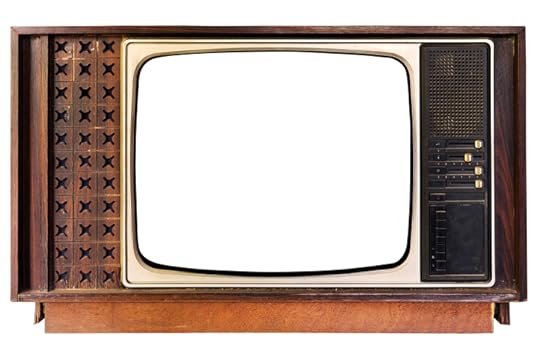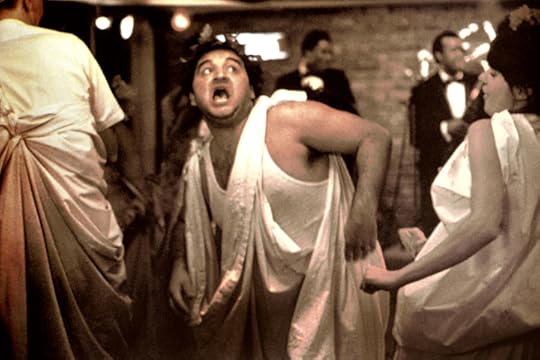Bathroom Readers' Institute's Blog, page 35
September 17, 2018
A Yummy, Gummy Origin Story

Here’s the tale of how humans came to eat bears—tiny, adorable, rainbow-colored Gummy Bears, that is.
Origin story
Not too long after the end of World War I in the early 1920s, a 27-year-old candy factory worker from Bonn, Germany, named Hans Riegel decided to quit his job and go into business for himself. He set up shop in his kitchen, with little more than a marble slab, water kettle, and industrial-sized bags of sugar to make colorless (but extremely sweet) hard candies. He sold them to local candy shops and at street festivals, delivered by bicycle via Riegel’s business partner: his wife, Gertrud. They named their very small operation Haribo, taking the first two letters of Hans, Riegel, and Bonn.
Ho-hum hard candies
The ho-hum hard candies sold moderately well, but Riegel thought he could do better—both financially and creatively. Candy was (and is) big business in Germany, and he wanted to create a classic that would be famous all over the world. He took his inspiration from gummies, made from sugar, gelatin, and flavoring to make for a rubbery, chewy, super-sweet treat. Germans particularly ate up wine-flavored gummies and gumdrops, but Riegel thought they lacked a certain something—they were just boring, shaped like balls, lumps, or discs.
Dancing bears
Then Riegel remembered something from the many street festivals where he and his wife had sold their hard candies. Kids loved to watch the specially-trained dancing bears at those celebrations, and so Riegel took bears and married them to gummies. The result: bear-shaped chewy gummy candies he called Tanzbaren (which translates to “dancing bears”). That first iteration of gummy bears wouldn’t be recognizable to today’s candy fans: they were long and slim, not cute and squat, but they were cheap. (Cost: two for the equivalent of a penny.) Also different than today’s candy bears: They only came in gold.
War years
Still, it was the business and imaginative breakthrough Riegel was after. Within 10 years, Haribo employed 200 candy-makers to churn out Tanzbaren. By World War II, that number had doubled…until Germany’s obsession with world domination during the 1930s and 1940s hampered business, and Haribo had almost shuttered by the time Riegel died in 1945. Within five years, his sons got this more happier part of German history up and running again, and even bigger than before.
Gummibarchen aka ‘little gummy bears”
In 1960, Tanzbaren became available outside of Germany for the first time, and that’s also when the Riegels changed the shape to smaller gummy bears and labeled them Gummibarchen, which means “little gummy bears.” Multiple colors hit the worldwide market in 1967, finalizing the evolution of this very popular candy.
The post A Yummy, Gummy Origin Story appeared first on Trivia Books and Facts | Uncle John's Bathroom Reader.
Man…or Superman?

Last week, Hollywood news outlets reported that Henry Cavill might be done playing Superman on the big screen, as he’s been doing since 2013 in films like Man of Steel, Justice League, and Batman vs. Superman. It remains to be seen who will next wear the cape…and who will have almost become the Man of Steel, like these actors who were considered for the part at various times over the years.
Paul Newman
Back when the first Superman was coming together in the 1970s, producers wanted to create a sweeping Hollywood epic for the ages, and they pursued as many legendary Hollywood stars as possible. They so wanted Paul Newman involved that they offered him $4 million to play…well, whatever role he wanted. Given a choice between playing Superman, Superman’s father Jor-El, or Lex Luthor, Newman chose “none of the above.”
Matt Bomer
In 2006, Superman Returns, the first new Superman movie in nearly 20 years, hit theaters, starring little-known actor Brandon Routh as Superman / Clark Kent (sorry, spoiler alert). He just edged out Matt Bomer, best known for his work on the TV show White Collar and the film Magic Mike. Bomber had actually already secured the part, but then director Brett Ratner quit, and Bryan Singer replaced him…and started from scratch with the script and the cast.
Burt Reynolds
In addition to declining the chance to play everyone from James Bond to Han Solo, Burt Reynolds could’ve portrayed the classic superhero, as he was on D.C. Comics short list of approved actors for the part back in the ‘70s.
D.J. Cotrona
Portraying Superman turned Cavill, a relatively little-known English actor, into an international superstar, a fate that likely would have come for Cotrona, had things worked out a little differently. Ten years before Justice League hit theaters, production was underway in 2007 on a movie called Justice League: Mortal. Sets had been constructed, and a cast was assembled, which including Armie Hammer as Batman and Cotrona as Superman, at the time best known for a horror movie called Venom and a short-lived Fox show called Skins. But then production fell apart due to budgetary concerns and the film was never made. (Cotrona at least went on to star in a G.I. Joe movie.)
Paul Walker
Before he rebooted Star Wars, J.J. Abrams took a shot at bringing Superman back to the big screen. In 2002, he headed up a movie called Superman: Flyby, and he and producers aggressively pursued the late The Fast and the Furious star Paul Walker. In 2003, about when the movie was canceled, Walker told reporters that although he was offered “a gazillion dollars,” he just wasn’t interested.
The post Man…or Superman? appeared first on Trivia Books and Facts | Uncle John's Bathroom Reader.
Acting on a Political Impulse

Sex and the City star Cynthia Nixon lost her bid to become the next governor of New York, losing in a primary to incumbent Andrew Cuomo. She’s certainly not the first well-known actor to ever run for office.
Shirley Temple
Her heyday was the 1930s, but Shirley Temple arguably remains the most famous (and beloved) child star of all time. She starred in tons of movies as a child and teenager, acting, charming, and singing her way through movies like Bright Eyes, Curly Top, and Heidi. Temple retired from acting at the ripe old age of 22 for a life of diplomacy. Temple (or rather Temple-Black) served as a representative to the United Nations, and was the U.S. Ambassador to both Ghana and Czechoslovakia. Temple tried to win elected office, but never got enough votes. She ran to fill an open California congressional seat in 1967 and came in a distant third.
Park Overall
This character actress is best known for her roles in the ‘80s as sharp, straight-talking Southerners, such as in the film adaptation of Neil Simon’s Biloxi Blues, and as the sassy Nurse Laverne on the long-running sitcom Empty Nest. Overall is also an outspoken environmentalist and frequent protestor against water pollution and nuclear energy. Those positions propelled her to a 2012 run in the Democratic primary for a U.S. Senate seat representing Tennessee. (She came in third.)
Nancy Kulp
Kulp has a slew of TV, film, and theater credits, but she’ll always be Miss Hathaway from The Beverly Hillbillies. Apart from entertainment, she was heavily involved in local politics in her home state of Pennsylvania. In 1984 she ran for a U.S. Congressional seat representing Pennsylvania’s ninth district, opposite incumbent Bud Shuster. Not so great for her campaign: Her old Beverly Hillbillies cohort Buddy Ebsen, a diehard Republican, offered to make an ad for Shuster…criticizing Kulp. She lost the election, and Ebsen later admitted he deeply regretted doing the commercial.
Fred Grandy
On TV’s The Love Boat, Grandy played “your ship’s purser,” Burl Smith…but everybody called him Gopher. When that series wound down after nine seasons in 1986, the TV veteran switched gears to politics…which he’d quietly pursued during his acting days, serving as a speechwriter for Wiley Mayne, the elected congressman from Grandy’s district in his home state of Iowa. Mayne was succeeded in his post by Berkley Bedell, but when he decided not to run for re-election in 1986, Grandy decided he’d give it a shot. And he won, edging out his opponent by a 51 to 49 percent vote. He wound up serving for eight years, stepping away in 1994 to run for governor of Iowa, an election he didn’t win.
The post Acting on a Political Impulse appeared first on Trivia Books and Facts | Uncle John's Bathroom Reader.
September 8, 2018
‘Star Wars’ – Starring Burt Reynolds as Han Solo
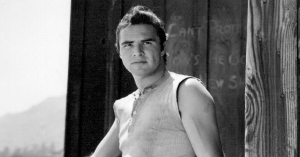
No, that didn’t really happen. The All-American king of ‘70s cinema and guys with mustaches, Burt Reynolds, passed away this week at the age of 82. He starred in plenty of classic movies, including Deliverance, The Longest Yard, and, of course, Smokey and the Bandit. But as much as Hollywood would have liked him to, he couldn’t be in everything. Here are some of the roles Reynolds turned down.
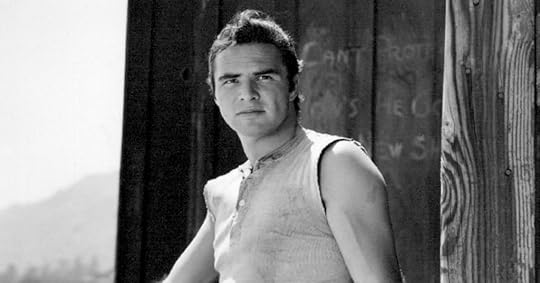
Reynolds. Burt Reynolds.
Reynolds could have been the first American actor to play what might be the most iconic and quintessentially British role of all time: secret agent 007, James Bond. In 1969, Bond movie producer Cubby Broccoli approached him. At the time, Reynolds wasn’t yet a movie superstar, but well known for his work on TV shows like Gunsmoke and Hawk. Reynolds listened to an impassioned, 10-minute pitch from Broccoli, but he turned it down, believing that an American just can’t play the spy extraordinaire. “Every night I wake up in a cold sweat,” Reynolds later (sort of?) joked about his decision.
They made him an offer he easily refused.
Al Pacino became a star and one of the most acclaimed actors of his generation after making a splash as reluctant crime family son Michael Corleone in 1972’s The Godfather, widely regarded as one of the greatest movies ever made. Reynolds was offered the part first, and he declined. The reason: Marlon Brando, already cast as boss Don Corleone, threatened to quit it Reynolds was cast. (One reason that was too bad—young Burt Reynolds looked exactly like the man who would’ve played his father.)
Burt Reynolds…walkin’ down the street…
One of the biggest hits of 1990 was the comedy Pretty Woman, starring Julia Roberts as a golden-hearted prostitute who falls in love with a suave businessman named Edward, played by Richard Gere. But Roberts’ Vivian could have fallen for Burt Reynolds as Edward. When asked on the talk show Watch What Happens Live why he turned down the future blockbuster, Reynolds quipped, “Because I’m an idiot.”
Jack attack!
Jack Nicholson took home the first of his three Academy Awards for playing rogue mental hospital resident Randle McMurphy in 1975’s One Flew Over the Cuckoo’s Nest. It’s a role that Reynolds desperately wanted to play, and lobbied hard to get…but producers went with Nicholson. Eight years later, Terms of Endearment director James L. Brooks offered him the role of Garrett Breedlove in eventual Best Picture Oscar winner Terms of Endearment. It shot at the same time as the race-car action comedy Stroker Ace, and Reynolds went with that one, because he felt he owed it to that film’s director, Hal Needham, who had given him huge career boosts by directing Smokey and the Bandit, The Cannonball Run, and Hooper. Nicholson played Breedlove…and won another darn Oscar for it.
A cosmic mistake?
Harrison Ford will forever be associated with Han Solo, the most dashing pilot in the galaxy in the Star Wars films. Burt Reynolds could have been Han, but he turned down director George Lucas because he just wasn’t into the idea of making a science-fiction movie.
The post ‘Star Wars’ – Starring Burt Reynolds as Han Solo appeared first on Trivia Books and Facts | Uncle John's Bathroom Reader.
September 7, 2018
It’s Easy to Win an Award (If You Know How)

It’s almost “awards season,” when every branch of the entertainment history holds lavish, televised parties to give one another trophies to recognize greatness. While Grammys, Emmys, and Oscars are voted on by a winner’s peers, there are some ways to game the system…just like these people did.

Who is Al Walser?
The 2013 Grammy Nominations were announced in December 2012. The category of Best Dance Recording recognized some heavy hitters, and looked to be a competitive category—chart-toppers including Avicii, Calvin Harris, Skrillex, and Swedish House Mafia. The fifth nomination, however, went to Al Walser. If you’re not familiar with dance music, you probably haven’t heard of him. Actually, if you are familiar with dance music, you probably haven’t heard of him either. At the time of his nomination, his Facebook page had 1,400 likes and his music videos on YouTube had amassed just 7,000 views. Walser is a Liechtenstein-born producer and DJ, and author of Musicians Make it Big: An Insider Reveals the Secret Path to Break into Today’s Music Industry. Perhaps the book covers his scrappy path to a Grammy nomination: He marketed himself on Grammy 365, a social network solely for Grammy voters, sending out 7,000 individual messages asking people to listen to his song. It worked (although he lost the award to Skrillex).
The Tourist and Burlesque? Seriously?
Two of the most critically savaged movies of 2010 were The Tourist, a confusing spy thriller starred Angelina Jolie and Johnny Depp; and Burlesque, a Cabaret-meets-Showgirls project starring Cher and Christina Aguilera. Neither film had any Oscar buzz, but both secured nominations for Best Picture: Musical or Comedy at the Golden Globes. How did that happen? The Golden Globes aren’t presented by an organization of film professionals (the Oscars, for example, are handed out by the Academy of Motion Picture Arts and Sciences). They’re awarded by the Hollywood Foreign Press Association—a collection of entertainment journalists. In the midst of the hubbub over the nominations for The Tourist and Burlesque, it was revealed that Sony, distributor of both movies, provided lavish, all-inclusive trips to Las Vegas for members of the HFPA. While they were there, writers got to attend an exclusive concert from Burlesque star Cher.
Who is Linda Chorney?
The musical genre of Americana is a soulful and hearty blend of country, folk, blues, and rock—think acts like Bonnie Raitt or Emmylou Harris, both of whom have won a Grammy Award for Best Americana Album. At the 2012 Grammys, Levon Helm beat out formidable nominees Ry Cooder, Lucinda Williams, Harris…and somebody named Linda Chorney, a singer-songwriter with six albums to her credit, all of them self-released. The album which landed her the Grammy nomination was called Emotional Jukebox, and at the time of her industry plaudit, not a single copy of the record had been sold. How did she get such top-shelf recognition? Like Walser, Chorney took a “grassroots” approach to Grammy campaigning, befriending and messaging Americana category voters on Grammy 365, the awards show’s social network. Chorney didn’t win of course, but she detailed her conscious plan to score a nomination in a book…which the very DIY-minded musician self-published.
The post It’s Easy to Win an Award (If You Know How) appeared first on Trivia Books and Facts | Uncle John's Bathroom Reader.
September 6, 2018
Movies That Spoiled Themselves

Don’t you hate it when you don’t get around to seeing the hot new Hollywood movie for a couple of weeks…and then a friend lets slip how it ends? It’s very aggravating. It’s perplexing then that some movies gave away their endings before they were even released.
ROCKY IV
Rocky IV is yet another Sylvester Stallone boxing drama starring the “Italian Stallion,” but set against the backdrop of the Cold War, and its decades-long tensions between the U.S. and the Soviet Union. In the movie, good old fashioned American Rocky Balboa goes up against the almost robotic Soviet super-boxer Ivan Drago. Who wins? Well, you can tell from the poster used to promote Rocky IV. It depicts Stallone triumphant at the end of a fight…wrapped up in an American flag.
GREASE
Grease is one of the most successful movies of all time, probably because of songs like “Summer Nights,” the nostalgic 1950 setting, and the star power of John Travolta and Olivia Newton-John as the leads. They play Danny and Sandy, respectively, two very different teenagers who finally fall in love despite the many obstacles placed in their way throughout the school year. Mostly their different stations in life keep them apart—Sandy is a conservatively dressed “good girl” (her friends derisively compare her to Doris Day and Sandra Dee), while Danny is a hot rod-racing greaser. Ultimately, they change for each other—Danny takes up track to be more mainstream, and Sandy shows up at the end of the mother dressed in a provocative leather outfit, and smoking a cigarette. It’s a shocking twist—and Olivia Newton-John was depicted in all of the promotional materials for Grease in that leather outfit.
THE PHANTOM MENACE
Despite notoriously underwhelming audiences, the first Star Wars prequel, The Phantom Menace, had a lot going for it—such as popular actor Liam Neeson in a leading role, playing a new Star Wars character, a mysterious Jedi named Qui-Gon Jinn. But prior to the film’s hugely anticipated release in May 1999 however, the movie’s orchestral soundtrack (composed by John Williams) hit music stores. One of the score tracks on the album: “Qui-Gon’s Funeral.” Spoiler alert: Qui-Gon dies in the The Phantom Menace.
SPEED
The 1994 action movie had a simple but compelling premise: If a Los Angeles city bus drops its speed under 50 miles per hour, a terrorist-planted bomb will explode. It’s up to a cop (Keanu Reeves) and a normal woman who takes over driving duties (Sandra Bullock) to save the bus, and everyone on it. Speed has a happy ending, with the passengers on board surviving the ordeal, despite the bus blowing up at one point. However, that explosion—and the passengers reacting to it, after their escape to safety—is all right there in the Speed trailer.
The post Movies That Spoiled Themselves appeared first on Trivia Books and Facts | Uncle John's Bathroom Reader.
September 4, 2018
TV of the 1930s?

The history of TV shows doesn’t start with the 1950s—that’s just when most Americans got their first TV set. Over in England, and in small and experimental broadcasts in the U.S, television was on in the air in the 1930s. Here are some of the first (and oddest) TV shows ever, long before I Love Lucy.
The Man with the Flower in His Mouth
The first dramatic program broadcast in the U.K. was this adaptation of a 1922 play by Italian writer Luigi Pirandello. It’s a short play of about 30 minutes that consists of a conversation between two men in a bar—one is dying, and the other is superficial.
Hints for Swimmers
In 1931, New York City experimental station W2XAB (which later became the first CBS affiliate in the U.S.) broadcast 28 hours of programming a week. One of its shows was this straightforwardly titled offering that gave viewers tips on how to swim better. (And it aired at 10:15 p.m.—primetime!)
The Television Ghost
Running for nearly two years on W2XAB was this 15-minute show literally about ghost stories. An actor, wearing white makeup and with a white towel over his head to look like a ghost, would play the spirit of a murder victim who would tell the story of his own demise. The camera stayed fixed on the head of the “ghost” for the entirety of the program.
Television Today
This summer of 1931 show featured Associated Press’s radio editor, Charles E. Butterfield, delivering educational lectures.
The Disorderly Room
It’s one of the first TV sitcoms, but it didn’t feature recurring characters doing different things each week. Rather, the same short comic play was broadcast in the U.K.—live, because recording technology didn’t exist—multiple times between 1937 and 1939. (The plot: Misbehaving army officers are reprimanded to the tune of well-known songs.)
Picture Page
This British series was among the first magazine-style programs, which included celebrity interviews, news reporting, and human interest stories. For some reason, the show’s framing device was an actress who played a telephone operator who would plug in wires to a switchboard to load up each segment of the show. It debuted in the early days of TV in 1936, and, taking a few years off for World War II, lasted all the way until 1952.
The post TV of the 1930s? appeared first on Trivia Books and Facts | Uncle John's Bathroom Reader.
August 20, 2018
Toga! Toga! Animal House Facts! Toga!
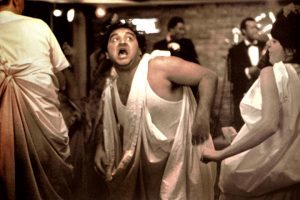
National Lampoon’s Animal House was released 40 years ago this summer. Here are some things you probably didn’t know about the classic college comedy.
Chevy Chase
Among the cast of young, relatively unknown actors playing fraternity guys in the movie was Saturday Night Live star John Belushi as Bluto. His SNL castmate Chevy Chase was almost in the cast, too. The role of smug and clever Otter (ultimately portrayed by Tim Matheson) was written for Chase, but director John Landis thought multiple SNL stars would take the audience out of the movie.
Other SNL vets that didn’t make the cast
The film as written by National Lampoon magazine writers Chris Miller, Harold Ramis, and Doug Kenney. Among their other initial casting choices, which Ramis wouldn’t have gone for, included SNL vets Dan Aykroyd as biker D-Day and Bill Murray as Boon.
Belushi, silent on purpose
Belushi’s performance is largely silent—he has very few lines. Landis did that on purpose—taking almost all of his lines out of the script, forcing Belushi to rely on physical comedy and facial expressions.
University of Oregon
The University of Oregon stood in for the film’s fictional Faber College. It’s the only college that would allow filming, even of such a raunchy film. Reportedly, the college’s dean had rejected an offer to have The Graduate film on campus years earlier, and he didn’t want to get burned again. (Dean Wormer’s office in Animal House was that U of O dean’s real office.)
Otis Day and the Knights
The Isley Brothers’ classic “Shout,” was performed in the movie by a raucous band called Otis Day and the Knights. Actor DeWayne Jessie played Otis, and got so popular from Animal House that he still tours bars and clubs today as a musician under the name Otis Day.
Who didn’t get rich?
The film was unexpectedly successful, grossing $141 million on a $3 million budget—a record at the time for a comedy. Who didn’t get rich off the movie? Donald Sutherland, who played a cool professor. Producers offered him either $75,000 salary for a percentage of the film’s returns. He thought the movie would flop, so he took the 75 grand. Had Sutherland had faith in the film, he’d have made about $4 million.
The sequels that never happened
Two Animal House sequels never panned out. One would’ve featured a predominantly female cast and focused on a ramshackle sorority house and its wild residents, while another would have reunited the cast about a decade after the events of Animal House in San Francisco in 1967 in the “Summer of Love.”
The post Toga! Toga! Animal House Facts! Toga! appeared first on Trivia Books and Facts | Uncle John's Bathroom Reader.
August 17, 2018
Long Live the Queen of Soul
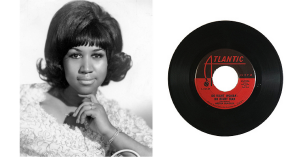
After a lengthy illness, Aretha Franklin, the Queen of Soul—and who Rolling Stone (among others) once called the greatest singer of all time—has passed away at age 76. Let’s all pay our R-E-S-P-E-C-Ts.
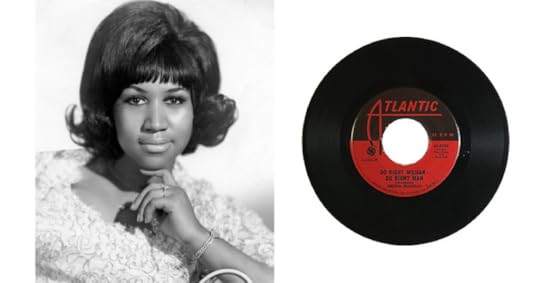
Queen of Prodigies
Music was a part of Franklin’s life from even before the beginning. She was born in the major American music city of Memphis, to a mother who was a professional pianist and singer and to a father who was a traveling minister. It was in church services run by her dad where Franklin first got to sing in public. Franklin’s mother died when the future superstar was nine-years-old…and so Franklin taught herself how to play the piano.
Queen of Opera
Franklin could sing soul of course, but she was incredibly versatile, able to handle a pop song (such as her ‘80s comeback hits “Freeway of Love” and “I Knew You Were Waiting For Me”), but she could even handle opera, a notoriously difficult and specialized discipline…and on a moment’s notice to boot. Perhaps the greatest operatic tenor in history, Luciano Pavarotti, was scheduled to perform his signature aria “Nessun Dorma” at the 1998 Grammy Awards. He took ill just before he was supposed to sing and canceled…and so his friend, Aretha Franklin filled in, and nailed it. She’d only had 20 minutes to prepare.
Queen of Blues
Franklin is best known for her timeless ‘60s hits like “Respect,” “Think,” and “Chain of Fools,” but she scored plenty of hit singles on the R&B chart into the ‘70s. She enjoyed a major mainstream comeback in the 1980s, which was triggered by her first of two film acting appearances in 1980’s The Blues Brothers. The studio wanted a younger act to play Mrs. Murphy and her backing musicians, like Rose Royce, who had a disco hit with “Car Wash.” Star and screenwriter Dan Aykroyd insisted on casting the Queen of Soul. (By the way, Franklin’s second film appearance: reprising her role as Mrs. Murphy in 1998’s Blues Brothers 2000.)
Queen of Shade
Franklin was a diva in the sense that she was an amazing singer, and also one who could, as the young people like to say, “throw shade.” She had a knack for delivering carefully-worded strategic putdowns. In 2014, a reporter for the Wall Street Journal asked Franklin to say the first thing that came to mind when different contemporary singers were named. While she said Whitney Houston “was a talent” and “had a gift,” Franklin said that Taylor Swift had “great gowns. Beautiful gowns.” As for rapper/singer Nicki Minaj, Franklin said, “Hmm, I’m gonna pass on that one.”
The post Long Live the Queen of Soul appeared first on Trivia Books and Facts | Uncle John's Bathroom Reader.
August 14, 2018
How to Make Movie Blood…

…and vomit, and other fake and forbidden substances, just like they do in Hollywood.

Blood
When an actor portrays a character that needs to be shot, their body is rigged with small, exploding capsules called squibs. When they’re set to go off, they spew out little bits of red substance to mimic blood of course. The most commonly used fake blood in the film industry is quite simple—regular, thick corn syrup dyed a deep red hue. Before the advent of color film, directors didn’t have to worry about a realistic shade. On the black-and-white film Psycho, for instance, Alfred Hitchcock simulated blood with chocolate syrup, which had the consistency he sought.
Marijuana
Performers don’t really use drugs in movies where their character does drugs. First of all, that would be quite illegal (depending on the drug and the place where the movie films), and also at least a little unhealthy. On The Pineapple Express, a comedy about marijuana, prop masters did use real marijuana, although it was a specially grown batch that had all of the “active ingredient,” or the intoxicating chemical, removed. On other movie sets, oregano has been the most commonly used fake-marijuana.
Cocaine
Cocaine is a white powder, but on movies not just any white powder will do, especially if actors have to ingest it. Some prop masters swear by lactose powder—milk-derived sugar—which doesn’t negatively affect the human body in small doses (unless the actor is lactose intolerant). On the drug-heavy movie The Wolf of Wall Street, the fake drug was Vitamin D powder. Actor Jonah Hill was required to ingest so much of it that he was hospitalized with bronchitis for three weeks.
Vomit
Pretend vomit, like real vomit, can take on a variety of colors and textures. Prop masters have known to make up batches that include stuff like oatmeal, coffee-based smoothies, baby food, tapioca, vegetable soup, and especially bananas. (When the possessed Regan in The Exorcist hurled, she hurled split pea soup.) The go-to fake-vomit base for decades was peach yogurt, but more recently Hollywood has turned to another, more accurate depiction: CGI.
The post How to Make Movie Blood… appeared first on Trivia Books and Facts | Uncle John's Bathroom Reader.





